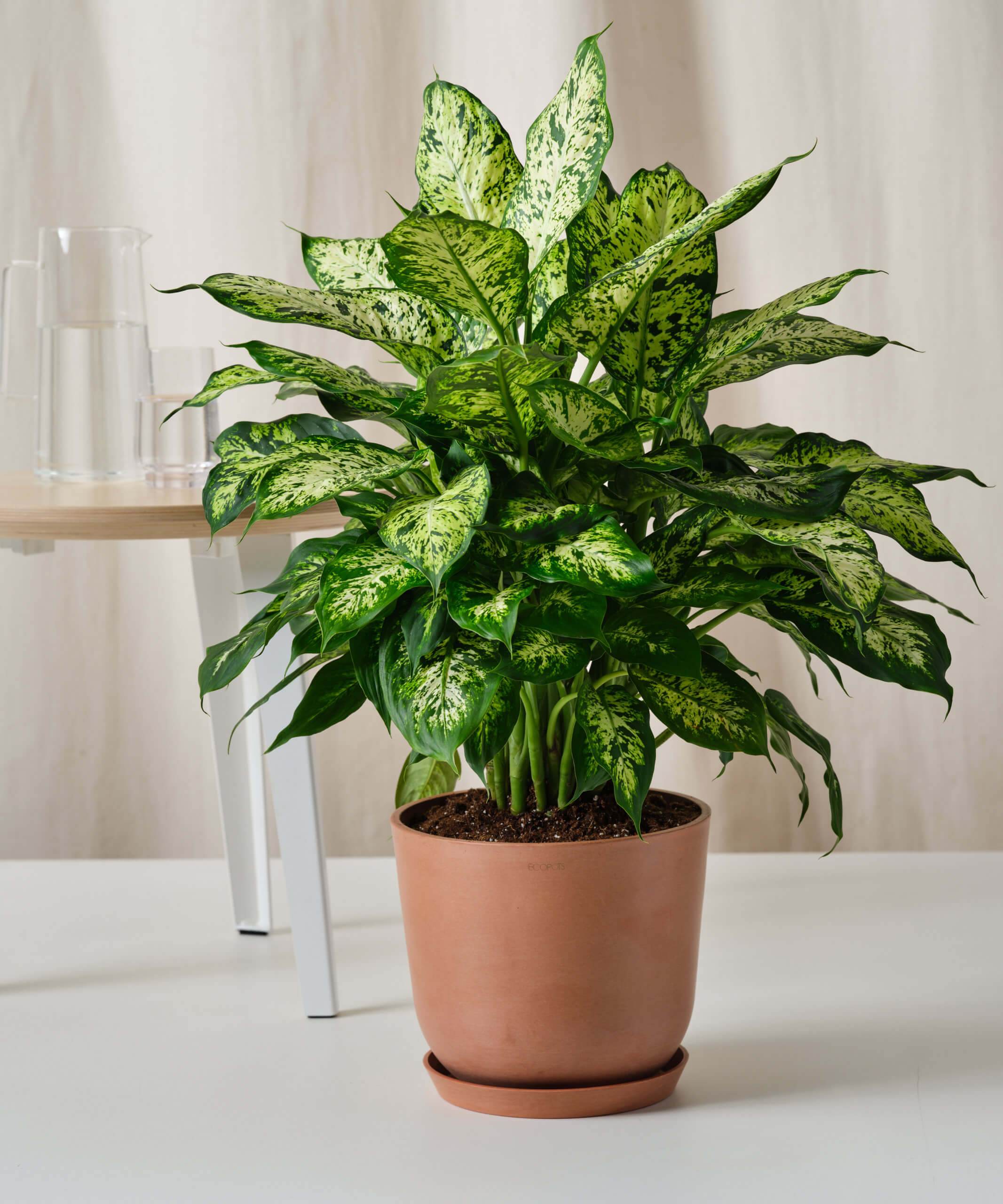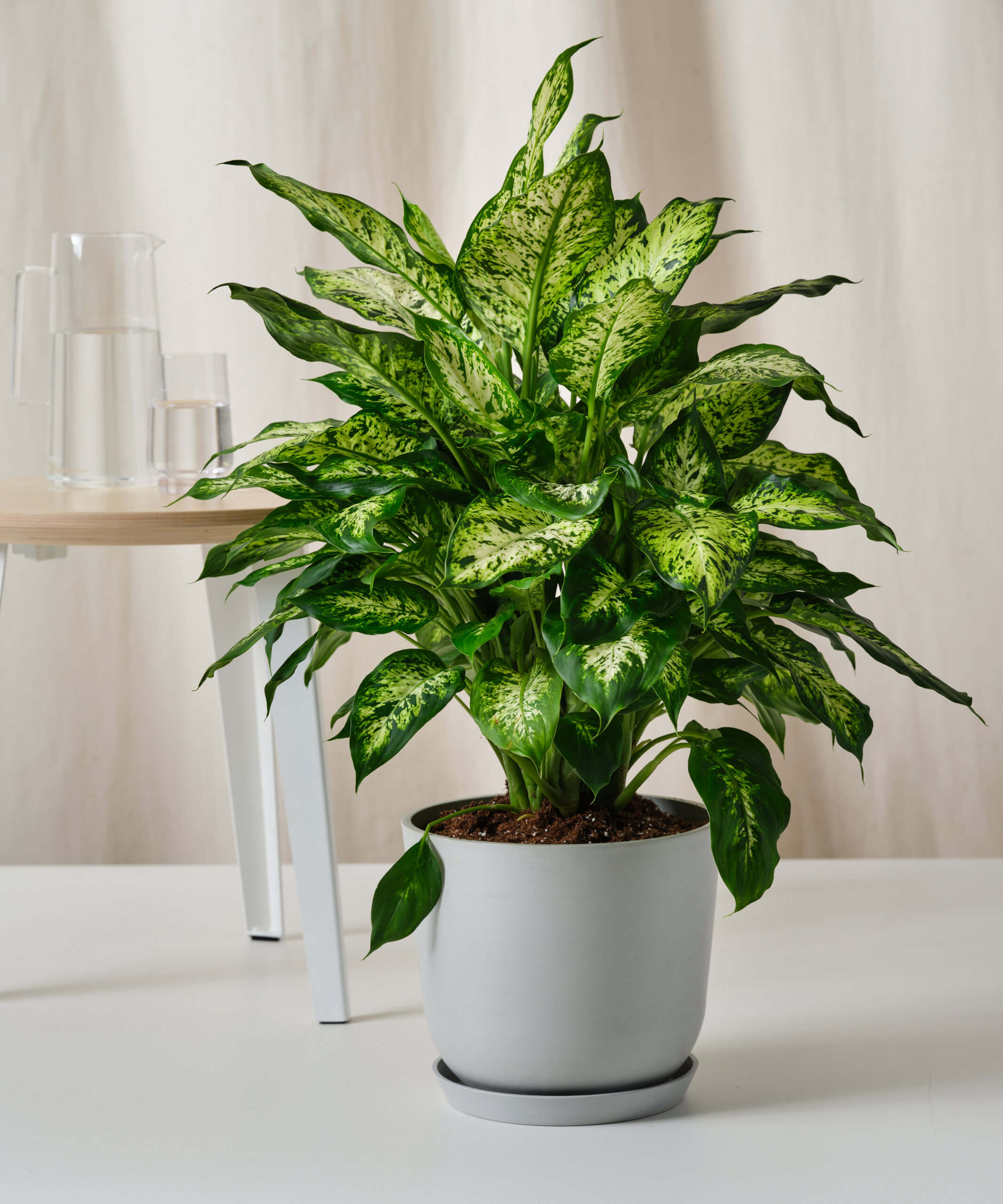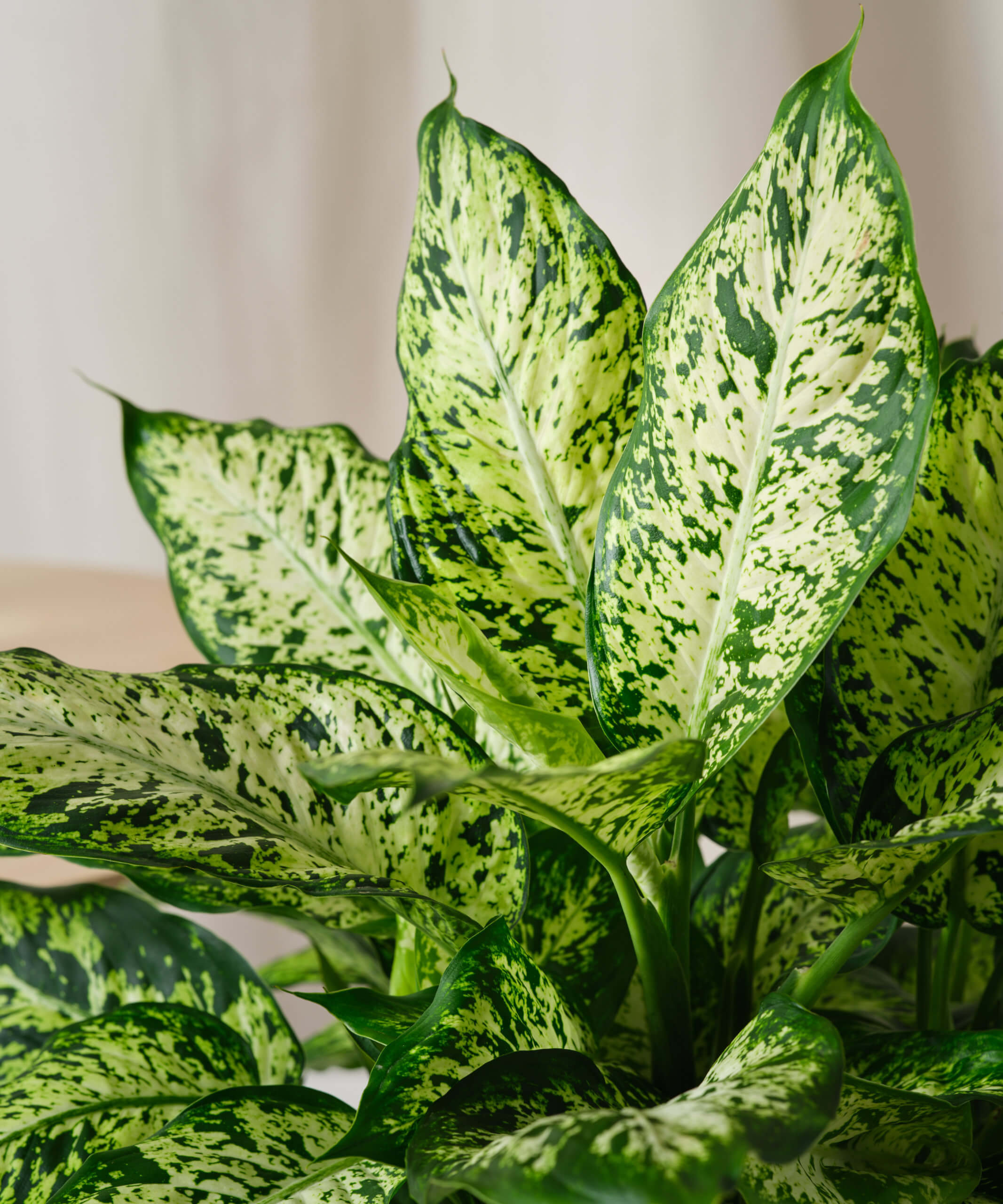Dieffenbachia Care
Water your Dieffenbachia when the soil volume is 50-75% dry. Water thoroughly until it drips out the bottom of the pot, and remove excess water that accumulates in the saucer.
Dieffenbachia Care

This vibrant, tropical, and easy-to-care-for plant will adapt to different environments and require little attention from you. The name Dumb Cane refers to the toxicity of its sap — if ingested, it will burn your mouth, numb your throat, and possibly paralyze the vocal cords. Not nice at all! If you can provide bright, indirect light, you will see your dieffenbachia’s mottling and vibrant markings proliferate. Low-light is no concern, however. As this indoor plant matures, its stem thickens, and the lower leaves drop, becoming statuesque small trees. It also produces flowers, which usually remain hidden beneath the showy foliage. You can remove the blooms to encourage more foliar growth.
Light
Most varieties do well in low light, but some dieffenbachia varieties like a little more indirect sunlight. In either case, the plants will live and thrive, but in lower light the growth might slow down. During the growing season, expose them to more indirect (never direct) light in order to facilitate healthy, new leaves.
Water
Over-watering this or any houseplant should be avoided. Although these plants don’t like to dry out completely, it’s important that they never sit in standing water. Conversely, the plant will also suffer if the soil becomes too dry. The goal is to keep the soil slightly moist without over-watering.
Soil
Dieffenbachias love loose, nutrient-rich potting soil. Use a soil medium that can retain moisture but also allows for draining excess water to avoid root rot. Most pre-mixed soils will suffice. Make sure that there is plenty of organic matter, like coco-coir, peat moss, or shredded leaves, and avoid soils that contain moisture retaining crystals. If your soil drains too quickly, we recommend re-potting your dieffenbachia into a compost-rich soil mixture, with less drainage materials. Learn how to create your own universal soil mixture for all of your indoor plants!
Temperature
60-85℉ is best for d ieffenbachia . If the temperature drops below 50℉, the plant will stop growing.
Humidity
Dieffenbachia love moisture in the air; more is always better. The goal should be to have a 60 percent humidity level throughout the year. You can place your plants atop a tray filled with water and pebbles, or use a humidifier. Misting the plant’s leaves is a temporary help, but isn’t enough to keep the humidity levels sufficient. Learn how to increase the humidity in the air around your indoor plants!
Fertilizer
During the growing season, feed the dieffenbachia half-strength complete liquid fertilizer. Don’t feed them in the winter months. If your dieffenbachia sits in brighter light, then fertilize more frequently.
Growth Rate
Dieffenbachia are moderate growers and when properly cared for and placed in a favorable environment, they can reach 6’+ indoors.
Pet Friend or Foe
Dieffenbachia are toxic to pets should be kept out of reach! Foe.
Pro Tips
- This plant is toxic. Keep it out of reach from pets and children.
- Lower leaf loss is common as your plant acclimates to its new home. Simply cut the lower leaves down at the base of the plant.
- Use a moisture meter for plants with a dense, full head.
- Wash your hands after handling any part of the plant, or wear protective gloves.
Dieffenbachia Care
There are many different species of Dieffenbachia, featuring many different interesting leaf patterns. Dieffenbachia are known for being a low-maintenance houseplant that will tolerate less-than-ideal conditions. They are a perfect choice for new or busy plant owners.

How to care for your Dieffenbachia
Use these instructions to care for a Dieffenbachia. This guide will tell you how to water a Dieffenbachia; its light, temperature, humidity preferences and any additional care it might need to help it grow.
Dieffenbachia
Your Dieffenbachia will do best in bright, indirect light. It can also tolerate lower light environments, though growth will slow. Avoid direct sunlight which can burn the leaves.
Water your Dieffenbachia when the soil volume is 50-75% dry. Water thoroughly until it drips out the bottom of the pot, and remove excess water that accumulates in the saucer.
The Dieffenbachia does fine in average household humidity. It won’t mind an added boost in humidity during the drier months of winter.
Your Dieffenbachia prefers temperatures between 60-80°F. Avoid cold drafts and sudden temperature changes.
Fertilize your Dieffenbachia once per month during the spring and summer with a general purpose houseplant fertilizer diluted to half-strength. Be sure the soil is damp; never apply fertilizer to dry soil.
Dieffenbachia are considered to be toxic to pets and humans if ingested.
If you notice the tips or edges of your plant’s leaves are turning brown, it could be due to your tap water. You can prevent this by watering with filtered water or rainwater. Remove any yellow leaves to keep your plant strong and growing.

Common Issues for your Dieffenbachia

Common Issue
Why are the leaves on my Dieffenbachia yellowing?

Common Issue
Why is my Dieffenbachia leggy?
Grow Beyond Expectations

What’s a Dieffenbachia?
Botanical Classification: Dieffenbachia spp. ‘Perfection Compacta’
About
Dieffenbachia are popular indoor plants for the home or office due to their regal appearance and the fact that they can grow between 3’ to 5’ indoors. They are very easy to care for, and if you run into any issues with over or under watering or lighting, it can rebound quickly when you course-correct on your care routine.
Native to Mexico, South America, and the West Indies, Dieffenbachia plants thrive in bright, indirect light, and can even adapt to fluorescent light, making them an office decoration hero. Just make sure to keep them away from children and pets as the leaves are mildly toxic!
Fun Fact
A common name for this plant is Leopard Lily, due to the distinctive striped pattern on Dieffenbachia leaves.